Analyzing the Ebola Outbreak: Causes, Effects, and West Africa Impact
VerifiedAdded on 2023/06/04
|7
|1552
|328
Essay
AI Summary
This essay provides a comprehensive analysis of the Ebola outbreak, focusing on its origins, transmission, and devastating effects, particularly in West Africa. It explores how the ebolavirus, likely originating in animals, spreads to humans through contact with infected bodily fluids or blood. The paper highlights the significant impact of the outbreak, including loss of life, increased demand for healthcare, and the emergence of Post-Ebola Virus Disease Syndrome (PEVDS) among survivors, characterized by symptoms such as fever, pain, and neurological conditions. The research also touches on the disruption of affected societies and the challenges in containing the virus, emphasizing the critical need for understanding and preparedness in handling future outbreaks. Desklib offers similar solved assignments for students.

Running Head: EBOLA OUTBREAK
Ebola Outbreak
Student’s Name
Institution
Ebola Outbreak
Student’s Name
Institution
Paraphrase This Document
Need a fresh take? Get an instant paraphrase of this document with our AI Paraphraser
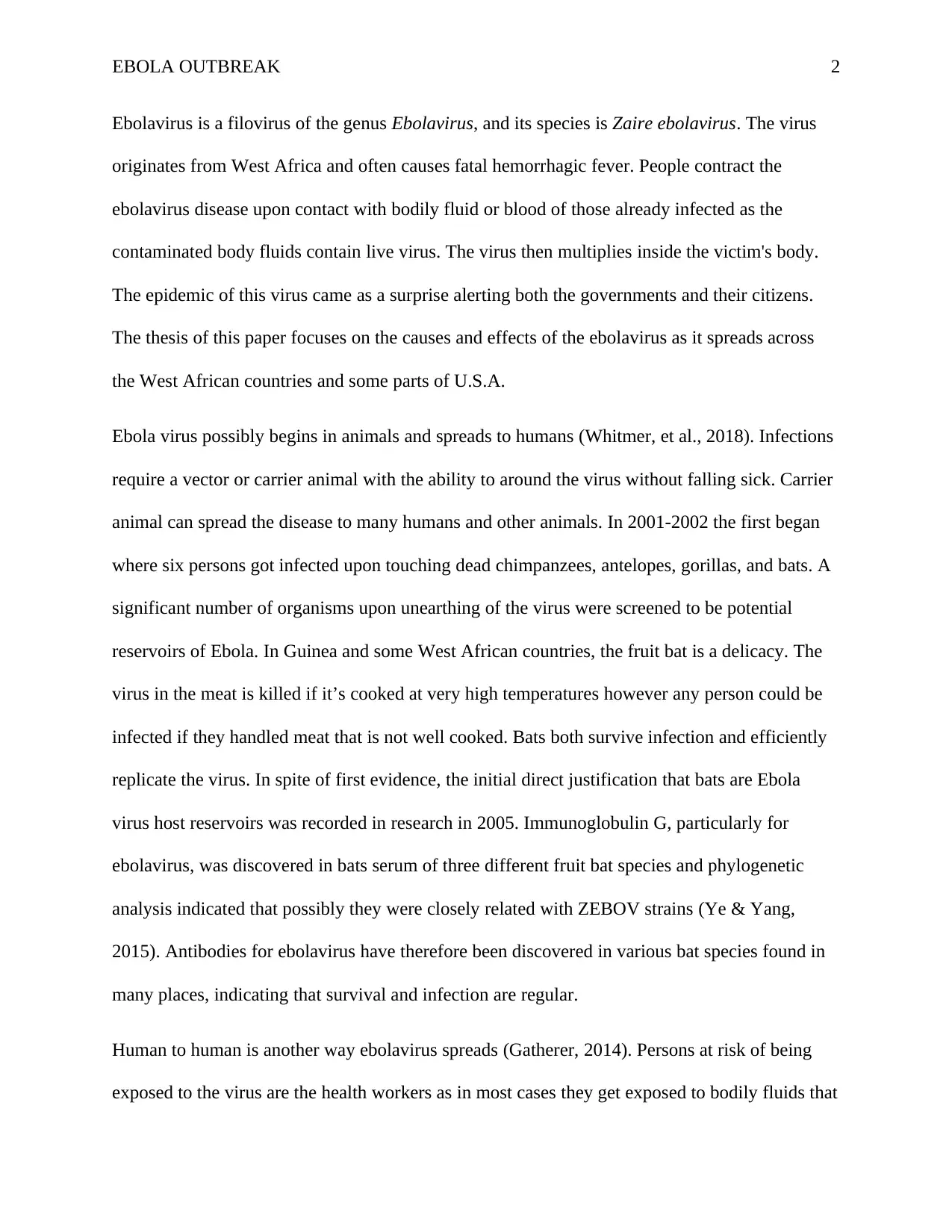
EBOLA OUTBREAK 2
Ebolavirus is a filovirus of the genus Ebolavirus, and its species is Zaire ebolavirus. The virus
originates from West Africa and often causes fatal hemorrhagic fever. People contract the
ebolavirus disease upon contact with bodily fluid or blood of those already infected as the
contaminated body fluids contain live virus. The virus then multiplies inside the victim's body.
The epidemic of this virus came as a surprise alerting both the governments and their citizens.
The thesis of this paper focuses on the causes and effects of the ebolavirus as it spreads across
the West African countries and some parts of U.S.A.
Ebola virus possibly begins in animals and spreads to humans (Whitmer, et al., 2018). Infections
require a vector or carrier animal with the ability to around the virus without falling sick. Carrier
animal can spread the disease to many humans and other animals. In 2001-2002 the first began
where six persons got infected upon touching dead chimpanzees, antelopes, gorillas, and bats. A
significant number of organisms upon unearthing of the virus were screened to be potential
reservoirs of Ebola. In Guinea and some West African countries, the fruit bat is a delicacy. The
virus in the meat is killed if it’s cooked at very high temperatures however any person could be
infected if they handled meat that is not well cooked. Bats both survive infection and efficiently
replicate the virus. In spite of first evidence, the initial direct justification that bats are Ebola
virus host reservoirs was recorded in research in 2005. Immunoglobulin G, particularly for
ebolavirus, was discovered in bats serum of three different fruit bat species and phylogenetic
analysis indicated that possibly they were closely related with ZEBOV strains (Ye & Yang,
2015). Antibodies for ebolavirus have therefore been discovered in various bat species found in
many places, indicating that survival and infection are regular.
Human to human is another way ebolavirus spreads (Gatherer, 2014). Persons at risk of being
exposed to the virus are the health workers as in most cases they get exposed to bodily fluids that
Ebolavirus is a filovirus of the genus Ebolavirus, and its species is Zaire ebolavirus. The virus
originates from West Africa and often causes fatal hemorrhagic fever. People contract the
ebolavirus disease upon contact with bodily fluid or blood of those already infected as the
contaminated body fluids contain live virus. The virus then multiplies inside the victim's body.
The epidemic of this virus came as a surprise alerting both the governments and their citizens.
The thesis of this paper focuses on the causes and effects of the ebolavirus as it spreads across
the West African countries and some parts of U.S.A.
Ebola virus possibly begins in animals and spreads to humans (Whitmer, et al., 2018). Infections
require a vector or carrier animal with the ability to around the virus without falling sick. Carrier
animal can spread the disease to many humans and other animals. In 2001-2002 the first began
where six persons got infected upon touching dead chimpanzees, antelopes, gorillas, and bats. A
significant number of organisms upon unearthing of the virus were screened to be potential
reservoirs of Ebola. In Guinea and some West African countries, the fruit bat is a delicacy. The
virus in the meat is killed if it’s cooked at very high temperatures however any person could be
infected if they handled meat that is not well cooked. Bats both survive infection and efficiently
replicate the virus. In spite of first evidence, the initial direct justification that bats are Ebola
virus host reservoirs was recorded in research in 2005. Immunoglobulin G, particularly for
ebolavirus, was discovered in bats serum of three different fruit bat species and phylogenetic
analysis indicated that possibly they were closely related with ZEBOV strains (Ye & Yang,
2015). Antibodies for ebolavirus have therefore been discovered in various bat species found in
many places, indicating that survival and infection are regular.
Human to human is another way ebolavirus spreads (Gatherer, 2014). Persons at risk of being
exposed to the virus are the health workers as in most cases they get exposed to bodily fluids that
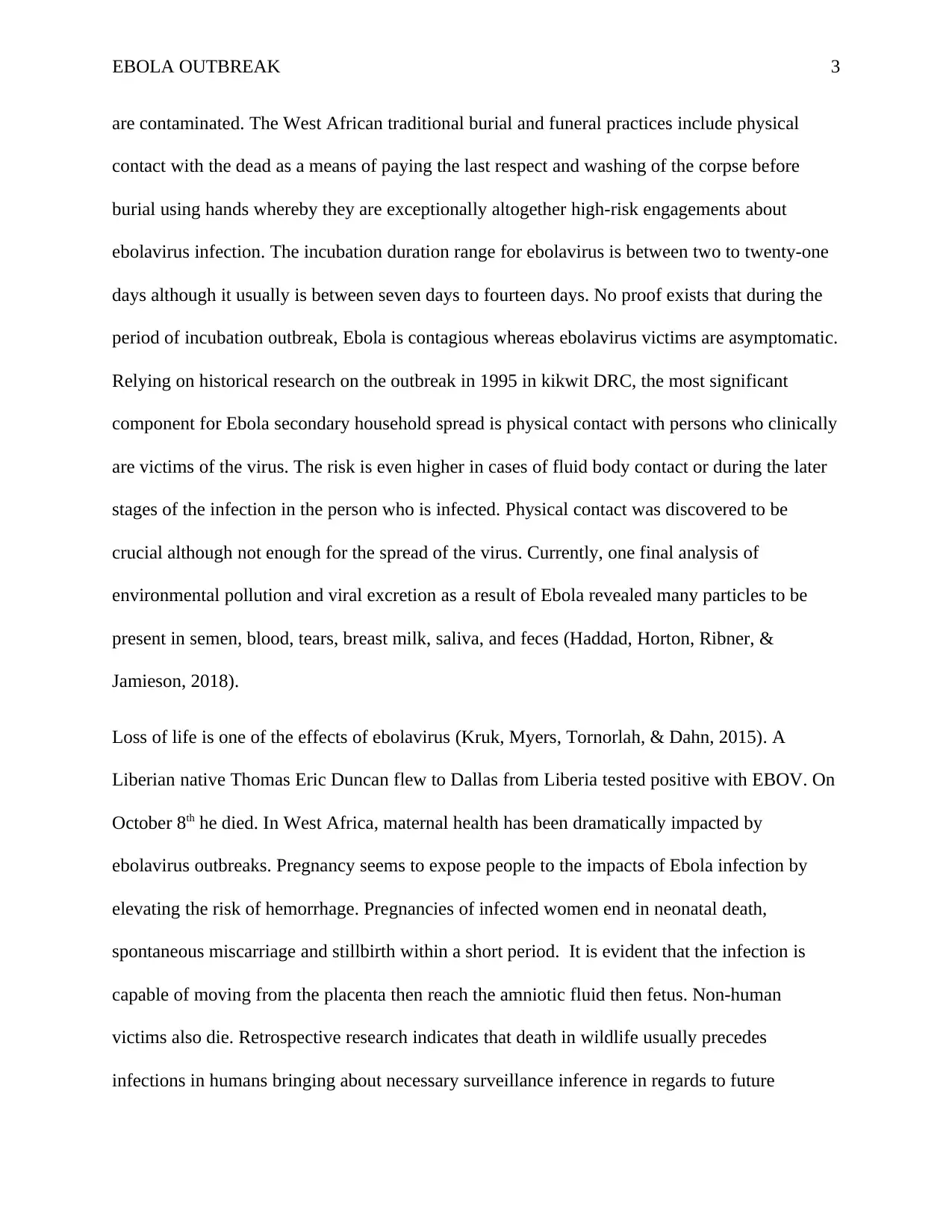
EBOLA OUTBREAK 3
are contaminated. The West African traditional burial and funeral practices include physical
contact with the dead as a means of paying the last respect and washing of the corpse before
burial using hands whereby they are exceptionally altogether high-risk engagements about
ebolavirus infection. The incubation duration range for ebolavirus is between two to twenty-one
days although it usually is between seven days to fourteen days. No proof exists that during the
period of incubation outbreak, Ebola is contagious whereas ebolavirus victims are asymptomatic.
Relying on historical research on the outbreak in 1995 in kikwit DRC, the most significant
component for Ebola secondary household spread is physical contact with persons who clinically
are victims of the virus. The risk is even higher in cases of fluid body contact or during the later
stages of the infection in the person who is infected. Physical contact was discovered to be
crucial although not enough for the spread of the virus. Currently, one final analysis of
environmental pollution and viral excretion as a result of Ebola revealed many particles to be
present in semen, blood, tears, breast milk, saliva, and feces (Haddad, Horton, Ribner, &
Jamieson, 2018).
Loss of life is one of the effects of ebolavirus (Kruk, Myers, Tornorlah, & Dahn, 2015). A
Liberian native Thomas Eric Duncan flew to Dallas from Liberia tested positive with EBOV. On
October 8th he died. In West Africa, maternal health has been dramatically impacted by
ebolavirus outbreaks. Pregnancy seems to expose people to the impacts of Ebola infection by
elevating the risk of hemorrhage. Pregnancies of infected women end in neonatal death,
spontaneous miscarriage and stillbirth within a short period. It is evident that the infection is
capable of moving from the placenta then reach the amniotic fluid then fetus. Non-human
victims also die. Retrospective research indicates that death in wildlife usually precedes
infections in humans bringing about necessary surveillance inference in regards to future
are contaminated. The West African traditional burial and funeral practices include physical
contact with the dead as a means of paying the last respect and washing of the corpse before
burial using hands whereby they are exceptionally altogether high-risk engagements about
ebolavirus infection. The incubation duration range for ebolavirus is between two to twenty-one
days although it usually is between seven days to fourteen days. No proof exists that during the
period of incubation outbreak, Ebola is contagious whereas ebolavirus victims are asymptomatic.
Relying on historical research on the outbreak in 1995 in kikwit DRC, the most significant
component for Ebola secondary household spread is physical contact with persons who clinically
are victims of the virus. The risk is even higher in cases of fluid body contact or during the later
stages of the infection in the person who is infected. Physical contact was discovered to be
crucial although not enough for the spread of the virus. Currently, one final analysis of
environmental pollution and viral excretion as a result of Ebola revealed many particles to be
present in semen, blood, tears, breast milk, saliva, and feces (Haddad, Horton, Ribner, &
Jamieson, 2018).
Loss of life is one of the effects of ebolavirus (Kruk, Myers, Tornorlah, & Dahn, 2015). A
Liberian native Thomas Eric Duncan flew to Dallas from Liberia tested positive with EBOV. On
October 8th he died. In West Africa, maternal health has been dramatically impacted by
ebolavirus outbreaks. Pregnancy seems to expose people to the impacts of Ebola infection by
elevating the risk of hemorrhage. Pregnancies of infected women end in neonatal death,
spontaneous miscarriage and stillbirth within a short period. It is evident that the infection is
capable of moving from the placenta then reach the amniotic fluid then fetus. Non-human
victims also die. Retrospective research indicates that death in wildlife usually precedes
infections in humans bringing about necessary surveillance inference in regards to future
⊘ This is a preview!⊘
Do you want full access?
Subscribe today to unlock all pages.

Trusted by 1+ million students worldwide
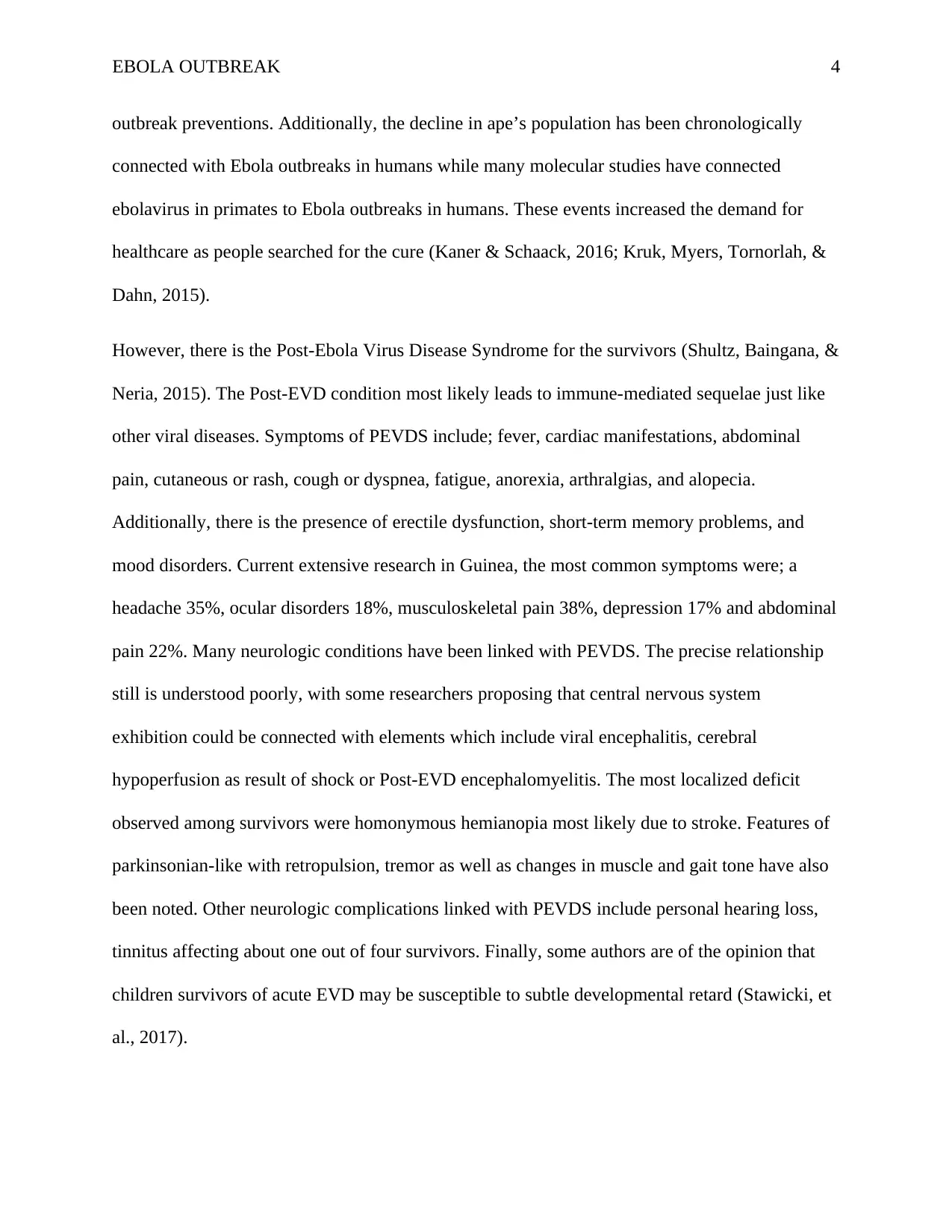
EBOLA OUTBREAK 4
outbreak preventions. Additionally, the decline in ape’s population has been chronologically
connected with Ebola outbreaks in humans while many molecular studies have connected
ebolavirus in primates to Ebola outbreaks in humans. These events increased the demand for
healthcare as people searched for the cure (Kaner & Schaack, 2016; Kruk, Myers, Tornorlah, &
Dahn, 2015).
However, there is the Post-Ebola Virus Disease Syndrome for the survivors (Shultz, Baingana, &
Neria, 2015). The Post-EVD condition most likely leads to immune-mediated sequelae just like
other viral diseases. Symptoms of PEVDS include; fever, cardiac manifestations, abdominal
pain, cutaneous or rash, cough or dyspnea, fatigue, anorexia, arthralgias, and alopecia.
Additionally, there is the presence of erectile dysfunction, short-term memory problems, and
mood disorders. Current extensive research in Guinea, the most common symptoms were; a
headache 35%, ocular disorders 18%, musculoskeletal pain 38%, depression 17% and abdominal
pain 22%. Many neurologic conditions have been linked with PEVDS. The precise relationship
still is understood poorly, with some researchers proposing that central nervous system
exhibition could be connected with elements which include viral encephalitis, cerebral
hypoperfusion as result of shock or Post-EVD encephalomyelitis. The most localized deficit
observed among survivors were homonymous hemianopia most likely due to stroke. Features of
parkinsonian-like with retropulsion, tremor as well as changes in muscle and gait tone have also
been noted. Other neurologic complications linked with PEVDS include personal hearing loss,
tinnitus affecting about one out of four survivors. Finally, some authors are of the opinion that
children survivors of acute EVD may be susceptible to subtle developmental retard (Stawicki, et
al., 2017).
outbreak preventions. Additionally, the decline in ape’s population has been chronologically
connected with Ebola outbreaks in humans while many molecular studies have connected
ebolavirus in primates to Ebola outbreaks in humans. These events increased the demand for
healthcare as people searched for the cure (Kaner & Schaack, 2016; Kruk, Myers, Tornorlah, &
Dahn, 2015).
However, there is the Post-Ebola Virus Disease Syndrome for the survivors (Shultz, Baingana, &
Neria, 2015). The Post-EVD condition most likely leads to immune-mediated sequelae just like
other viral diseases. Symptoms of PEVDS include; fever, cardiac manifestations, abdominal
pain, cutaneous or rash, cough or dyspnea, fatigue, anorexia, arthralgias, and alopecia.
Additionally, there is the presence of erectile dysfunction, short-term memory problems, and
mood disorders. Current extensive research in Guinea, the most common symptoms were; a
headache 35%, ocular disorders 18%, musculoskeletal pain 38%, depression 17% and abdominal
pain 22%. Many neurologic conditions have been linked with PEVDS. The precise relationship
still is understood poorly, with some researchers proposing that central nervous system
exhibition could be connected with elements which include viral encephalitis, cerebral
hypoperfusion as result of shock or Post-EVD encephalomyelitis. The most localized deficit
observed among survivors were homonymous hemianopia most likely due to stroke. Features of
parkinsonian-like with retropulsion, tremor as well as changes in muscle and gait tone have also
been noted. Other neurologic complications linked with PEVDS include personal hearing loss,
tinnitus affecting about one out of four survivors. Finally, some authors are of the opinion that
children survivors of acute EVD may be susceptible to subtle developmental retard (Stawicki, et
al., 2017).
Paraphrase This Document
Need a fresh take? Get an instant paraphrase of this document with our AI Paraphraser
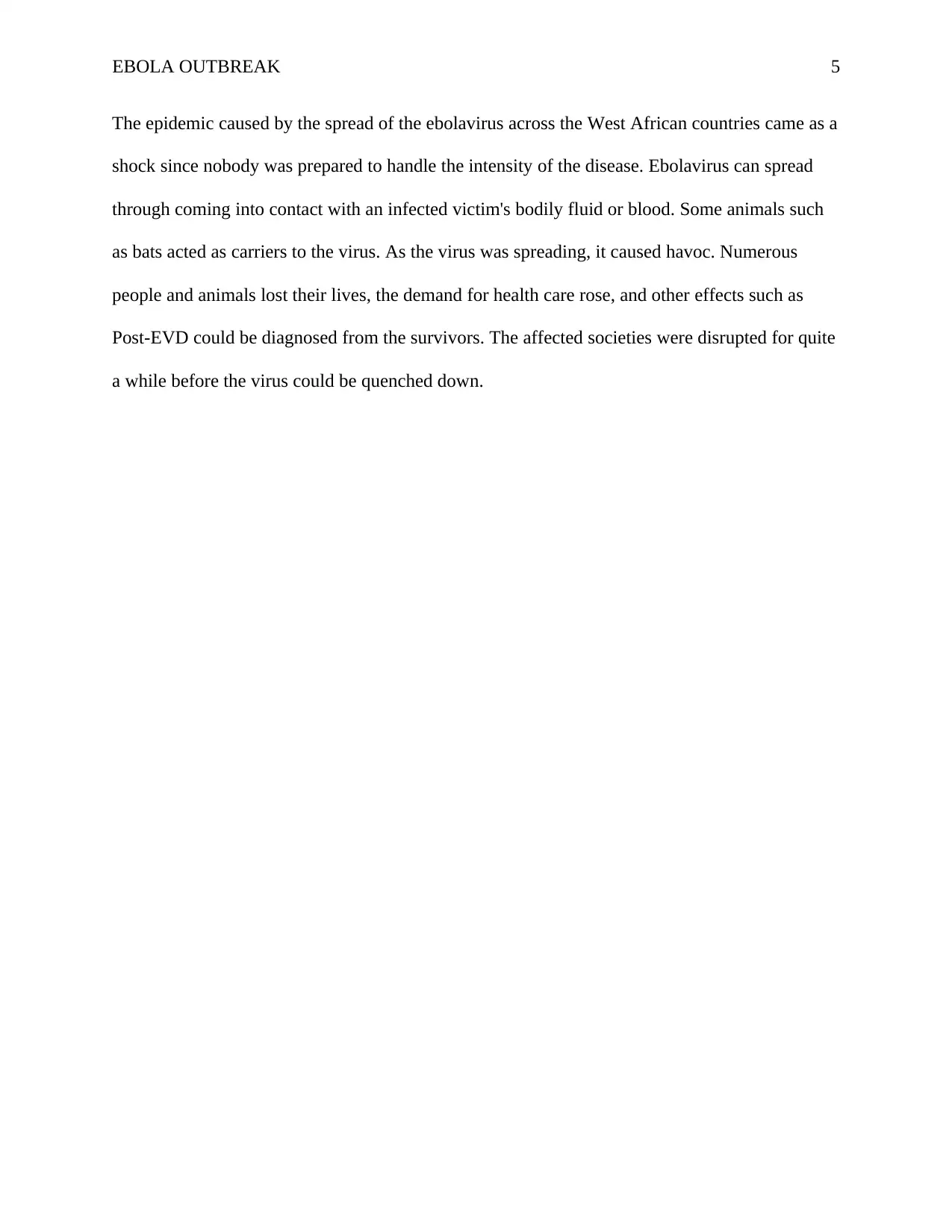
EBOLA OUTBREAK 5
The epidemic caused by the spread of the ebolavirus across the West African countries came as a
shock since nobody was prepared to handle the intensity of the disease. Ebolavirus can spread
through coming into contact with an infected victim's bodily fluid or blood. Some animals such
as bats acted as carriers to the virus. As the virus was spreading, it caused havoc. Numerous
people and animals lost their lives, the demand for health care rose, and other effects such as
Post-EVD could be diagnosed from the survivors. The affected societies were disrupted for quite
a while before the virus could be quenched down.
The epidemic caused by the spread of the ebolavirus across the West African countries came as a
shock since nobody was prepared to handle the intensity of the disease. Ebolavirus can spread
through coming into contact with an infected victim's bodily fluid or blood. Some animals such
as bats acted as carriers to the virus. As the virus was spreading, it caused havoc. Numerous
people and animals lost their lives, the demand for health care rose, and other effects such as
Post-EVD could be diagnosed from the survivors. The affected societies were disrupted for quite
a while before the virus could be quenched down.
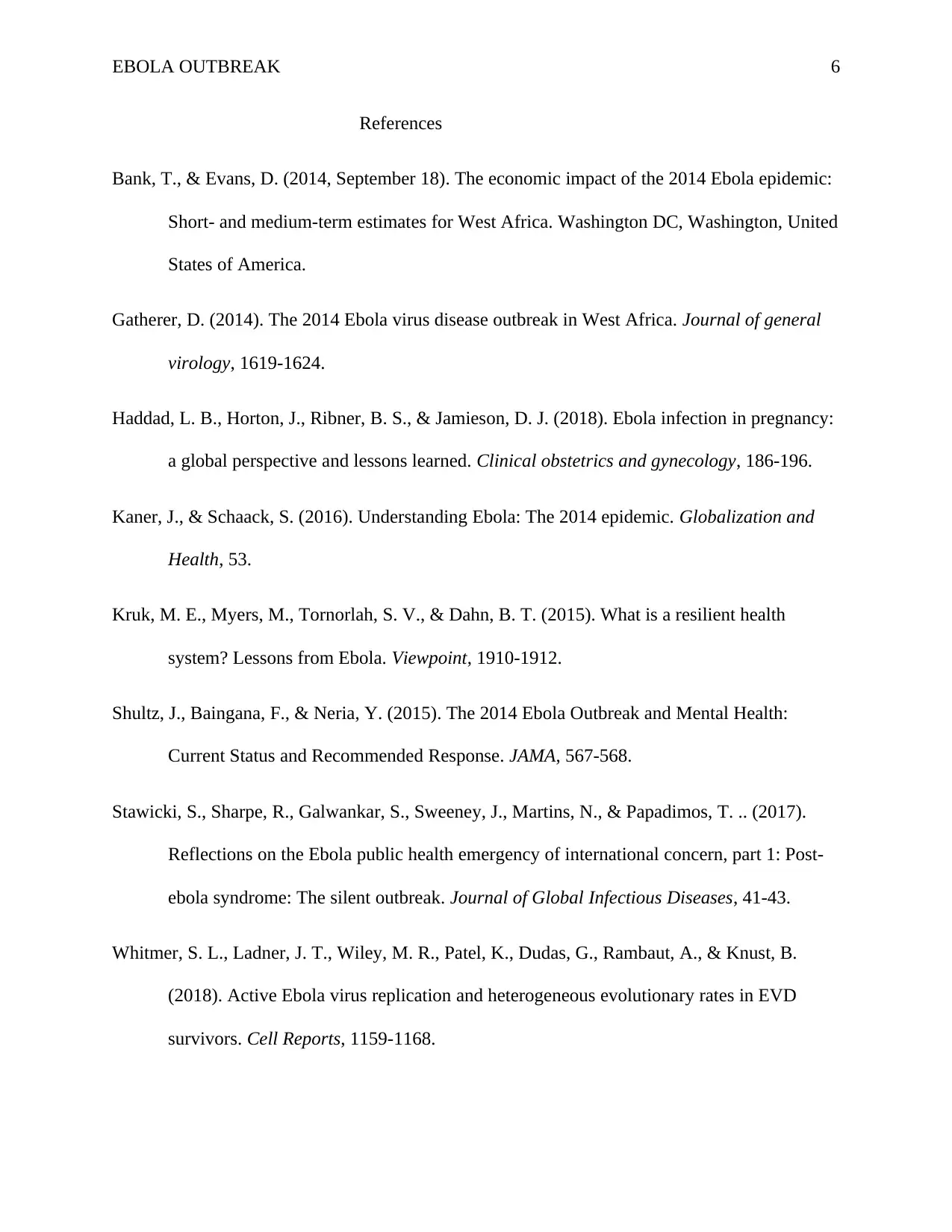
EBOLA OUTBREAK 6
References
Bank, T., & Evans, D. (2014, September 18). The economic impact of the 2014 Ebola epidemic:
Short- and medium-term estimates for West Africa. Washington DC, Washington, United
States of America.
Gatherer, D. (2014). The 2014 Ebola virus disease outbreak in West Africa. Journal of general
virology, 1619-1624.
Haddad, L. B., Horton, J., Ribner, B. S., & Jamieson, D. J. (2018). Ebola infection in pregnancy:
a global perspective and lessons learned. Clinical obstetrics and gynecology, 186-196.
Kaner, J., & Schaack, S. (2016). Understanding Ebola: The 2014 epidemic. Globalization and
Health, 53.
Kruk, M. E., Myers, M., Tornorlah, S. V., & Dahn, B. T. (2015). What is a resilient health
system? Lessons from Ebola. Viewpoint, 1910-1912.
Shultz, J., Baingana, F., & Neria, Y. (2015). The 2014 Ebola Outbreak and Mental Health:
Current Status and Recommended Response. JAMA, 567-568.
Stawicki, S., Sharpe, R., Galwankar, S., Sweeney, J., Martins, N., & Papadimos, T. .. (2017).
Reflections on the Ebola public health emergency of international concern, part 1: Post-
ebola syndrome: The silent outbreak. Journal of Global Infectious Diseases, 41-43.
Whitmer, S. L., Ladner, J. T., Wiley, M. R., Patel, K., Dudas, G., Rambaut, A., & Knust, B.
(2018). Active Ebola virus replication and heterogeneous evolutionary rates in EVD
survivors. Cell Reports, 1159-1168.
References
Bank, T., & Evans, D. (2014, September 18). The economic impact of the 2014 Ebola epidemic:
Short- and medium-term estimates for West Africa. Washington DC, Washington, United
States of America.
Gatherer, D. (2014). The 2014 Ebola virus disease outbreak in West Africa. Journal of general
virology, 1619-1624.
Haddad, L. B., Horton, J., Ribner, B. S., & Jamieson, D. J. (2018). Ebola infection in pregnancy:
a global perspective and lessons learned. Clinical obstetrics and gynecology, 186-196.
Kaner, J., & Schaack, S. (2016). Understanding Ebola: The 2014 epidemic. Globalization and
Health, 53.
Kruk, M. E., Myers, M., Tornorlah, S. V., & Dahn, B. T. (2015). What is a resilient health
system? Lessons from Ebola. Viewpoint, 1910-1912.
Shultz, J., Baingana, F., & Neria, Y. (2015). The 2014 Ebola Outbreak and Mental Health:
Current Status and Recommended Response. JAMA, 567-568.
Stawicki, S., Sharpe, R., Galwankar, S., Sweeney, J., Martins, N., & Papadimos, T. .. (2017).
Reflections on the Ebola public health emergency of international concern, part 1: Post-
ebola syndrome: The silent outbreak. Journal of Global Infectious Diseases, 41-43.
Whitmer, S. L., Ladner, J. T., Wiley, M. R., Patel, K., Dudas, G., Rambaut, A., & Knust, B.
(2018). Active Ebola virus replication and heterogeneous evolutionary rates in EVD
survivors. Cell Reports, 1159-1168.
⊘ This is a preview!⊘
Do you want full access?
Subscribe today to unlock all pages.

Trusted by 1+ million students worldwide

EBOLA OUTBREAK 7
Ye, L., & Yang, C. (2015). Development of vaccines for prevention of Ebola virus infection.
Microbes and infection, 98-108.
Ye, L., & Yang, C. (2015). Development of vaccines for prevention of Ebola virus infection.
Microbes and infection, 98-108.
1 out of 7
Related Documents
Your All-in-One AI-Powered Toolkit for Academic Success.
+13062052269
info@desklib.com
Available 24*7 on WhatsApp / Email
![[object Object]](/_next/static/media/star-bottom.7253800d.svg)
Unlock your academic potential
Copyright © 2020–2025 A2Z Services. All Rights Reserved. Developed and managed by ZUCOL.





